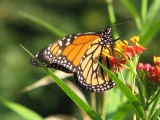Hemogregarines are common intracellular blood parasites found in freshwater turtles and leeches which serve as the vector to turtles. We are planning a project to investigate if behavior of aquatic turtles impacts Haemogregarine infections and if parasites have coevolved with their hosts. Throughout the summer we will be trapping aquatic turtles and testing blood samples … Continue reading
Filed under Empirical …
MHC diversity and disease risk for the endangered Florida pumas
The Florida puma (Puma concolor coryi) is an endangered subspecies of puma that is found exclusively in southern Florida. This population (currently 100-150 individuals) is threatened by inbreeding depression, habitat encroachment and disease. The release of eight Texas puma (P. c. stanleyana) females into south Florida in 1995 as part of a genetic restoration program is … Continue reading
Microbial interactions in disease-causing mosquitoes
Most animals harbor a diverse community of microorganisms in their digestive tracts, which is referred to as the gut microbiome. The gut microbiome plays essential roles in animal growth and development. It can also directly or indirectly affect the ability of disease causing pathogens to infect animals. Our studies focus on mosquitoes that transmit human … Continue reading
Feeding a fever: mounting an immune response in the face of limited resources
Host immune defenses can offer powerful protection against infectious diseases. These defenses are assumed to be costly and can trade-off against reproduction or other activities. This experimental project will use monarch butterflies and a debilitating protozoan parasite that attacks them to examine how costly host immune defenses are (in terms of reproduction, growth, and lipid reserves), and to ask what … Continue reading
Urbanization, cross-species transmission, and pathogen evolution
Urban development has many effects on wildlife — including what diseases they get. The goal of this study is to estimate the frequency of interspecies bacterial pathogen transmission between raccoons (Procyon lotor) and feral cats (Felis catus) in response to urbanization. Our study pathogens are Mycoplasma and Bartonella bacteria, including pathogens that are a significant … Continue reading
When worms compete, who wins?
Most animal species harbor many parasite species at the same time. For example, a single zebra can host up to 20 species of worms in its gastrointestinal (GI) tract. Much like trees in a forest or barnacles on a shoreline, individual parasites that co-occur in the same habitat often compete vigorously for space and resources. … Continue reading
Finding Reservoirs of American trypanosomiasis and leishmaniasis in Panama
America trypanosomiasis (Chagas disease), and American cutaneous leishmaniasis (ACL) are vector-borne protozoan infections that cause significant morbidity and/or mortality in human populations in Latin America. Little is understood about the relative competence of the different wild mammal hosts of Chagas disease and ACL. The REU participant in this study will have an opportunity to evaluate … Continue reading
Pathogen survival in a contaminated environment
Host-pathogen interactions occur in a complicated world, subject to a multitude of human-induced stressors. This project will examine the impact of one such stressor on the host-pathogen interaction between a yeast (Metschnikowia bicuspidata) parasitic to a zooplankton host (Daphnia dentifera). Pesticides enter aquatic systems through agricultural runoff, and have the potential to alter community composition, host … Continue reading
White pox disease of elkhorn coral
Coral reefs worldwide are in severe decline. In the Caribbean, the once common reef-building elkhorn coral (Acropora palmata) is showing high rates of decline due to bleaching, hurricanes, and disease. In the Florida Keys, 87% of the population has already been lost. Since 1996, the majority of this loss has been attributed to a previously … Continue reading
Effects of temperature and predation on immune response
How does stress influence disease? Environmental stresses often act synergistically to affect disease susceptibility in hosts, but the mechanisms behind how these stresses operate are often unclear. Two common stresses influencing the prevalence of diseases in oysters are temperature and predators. Using experiments, this project will examine how temperature influences immune response and disease susceptibility in oysters. Also we will … Continue reading





